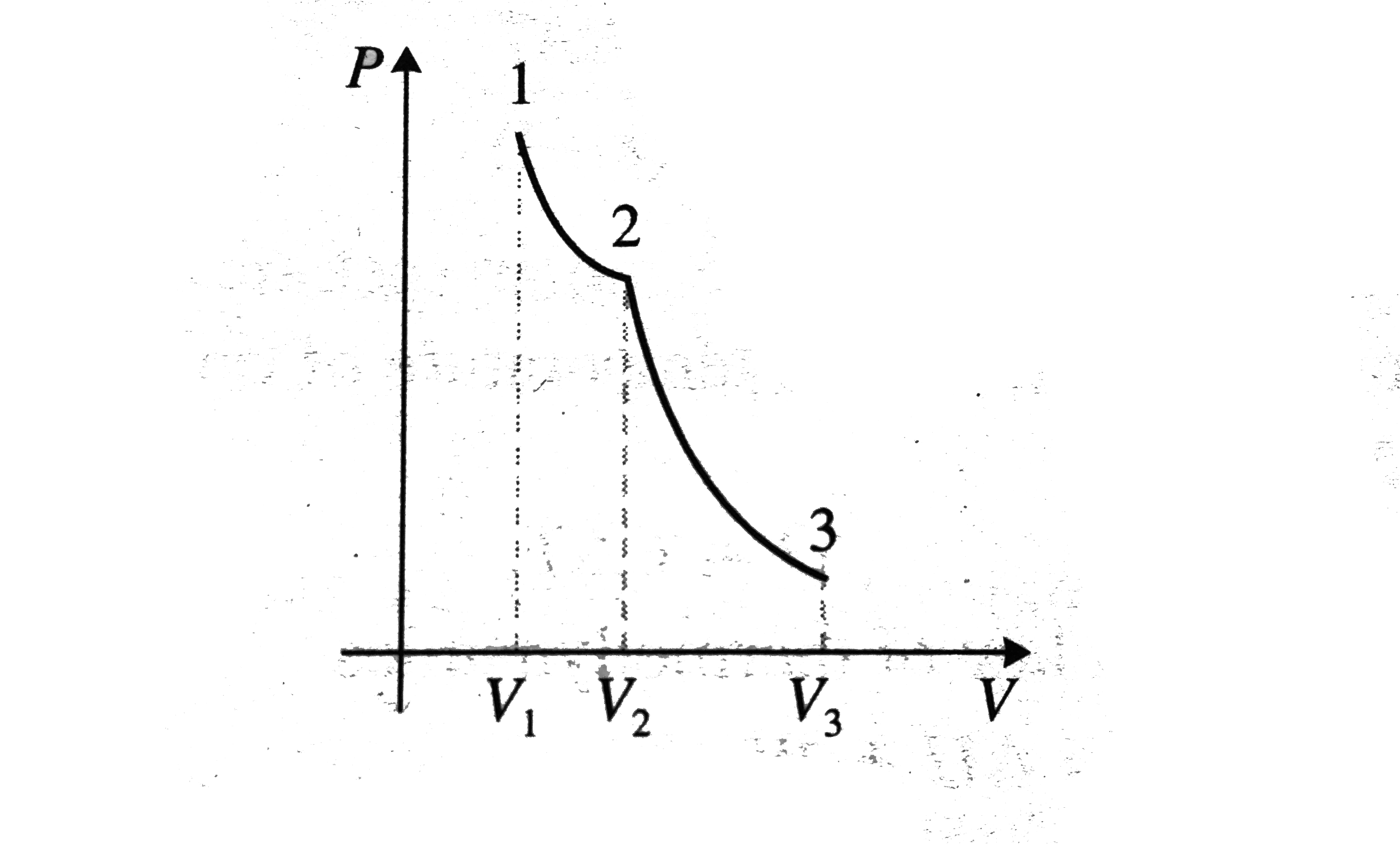Initial pressure and volume of a gas are P and V respectively. First its volume is expanded to 4V by isothermal process and then again its volume makes to be V by adiabatic process then its final pressure is (γ=1.5) -
8P
4P
P
2P
The correct Answer is:D
To solve the problem step-by-step, we will analyze the two processes the gas undergoes: an isothermal expansion followed by an adiabatic compression.
Step 1: Understand the Initial Conditions
The initial pressure and volume of the gas are given as P and V respectively.
Step 2: Isothermal Expansion
The gas expands isothermally from volume V to 4V. In an isothermal process, the product of pressure and volume remains constant, which can be expressed as:
PV=nRT
Since the temperature T remains constant, we can write:
P⋅V=P′⋅(4V)
Where P′ is the pressure after the isothermal expansion.
Rearranging gives:
P′=P⋅V4V=P4
Thus, after the isothermal expansion, the pressure P′ is P4.
Step 3: Adiabatic Compression
Next, the gas undergoes an adiabatic process where its volume changes from 4V back to V. For an adiabatic process, we use the relation:
PVγ=constant
Applying this to the initial and final states of the adiabatic process, we have:
P′⋅(4V)γ=PC⋅Vγ
Where PC is the final pressure after the adiabatic process.
Substituting P′=P4:
P4⋅(4V)γ=PC⋅Vγ
This simplifies to:
P4⋅4γ⋅Vγ=PC⋅Vγ
Dividing both sides by Vγ:
P⋅4γ4=PC
This simplifies to:
PC=P⋅4γ4=P⋅4γ−1
Step 4: Substitute the Value of γ
Given that γ=1.5:
PC=P⋅41.5−1=P⋅40.5=P⋅2
Thus, the final pressure PC is:
PC=2P
Final Answer
The final pressure of the gas after the two processes is 2P.
---
The initial pressure and volume of the gas are given as P and V respectively.
The gas expands isothermally from volume V to 4V. In an isothermal process, the product of pressure and volume remains constant, which can be expressed as:
PV=nRT
Since the temperature T remains constant, we can write:
P⋅V=P′⋅(4V)
Where P′ is the pressure after the isothermal expansion.
P′=P⋅V4V=P4
Thus, after the isothermal expansion, the pressure P′ is P4.
Next, the gas undergoes an adiabatic process where its volume changes from 4V back to V. For an adiabatic process, we use the relation:
PVγ=constant
Applying this to the initial and final states of the adiabatic process, we have:
P′⋅(4V)γ=PC⋅Vγ
Where PC is the final pressure after the adiabatic process.
P4⋅(4V)γ=PC⋅Vγ
This simplifies to:
P4⋅4γ⋅Vγ=PC⋅Vγ
Dividing both sides by Vγ:
P⋅4γ4=PC
This simplifies to:
PC=P⋅4γ4=P⋅4γ−1
Given that γ=1.5:
PC=P⋅41.5−1=P⋅40.5=P⋅2
Thus, the final pressure PC is:
PC=2P
The final pressure of the gas after the two processes is 2P.
Similar Questions
An ideal gas of volume V and pressure P expands isothermally to volume 16 V and then compressed adiabatically to volume V . The final pressure of gas is [γ=1.5]
View SolutionThe pressure p and volume V of an ideal gas both increase in a process.
View SolutionThe pressure P and volume V of an ideal gas both decreases in a process.
View SolutionA monatomic gas at a pressure P, having a volume V expands isothermally to a volume 2 V and then adiabatically to a volume 16 V. The final pressure of the gas is ( take γ=53)
View SolutionA monoatomic gas at a pressure p, having a volume 2V and then adiabatically to a volume 16 V. The final pressure of the gas is (take γ=53 )
View SolutionOne mole of a perfect gas, initally at a pressure and temperature of 105N/m2 and 300 K, respectively, expands isothermally unitl its volume is doubled and then adiabatically until its volume is again doubled. Find final pressure and temperature of the gas Find the total work done during the isothermal and adiabatic processes. Given γ=1.4. Also draw the P-V diagram for the process.

View SolutionA closed gas cylinder is divided into two parts by a piston held tight. The pressure and volume of gas in two parts respectively are (P, 5V) and (10P, V). If now the piston is left free and the system undergoes isothermal process, then the volumes of the gas in two parts respectively are
View SolutionAn ideal gas with pressure P, volume V and temperature T is expanded isothermally to a volume 2V and a final pressure Pi, If the same gas is expanded adiabatically to a volume 2V, the final pressure Pa. The ratio of the specific heats of the gas is 1.67. The ratio PaP1 is .......
View SolutionAn ideal gas with pressure P, volume V and temperature T is expanded isothermally to a volume 2V and a final pressure Pi, If the same gas is expanded adiabatically to a volume 2V, the final pressure Pa. The ratio of the specific heats of the gas is 1.67. The ratio PaP1 is .......
View SolutionAn ideal gas has initial volume V and pressure p. In doubling its volume the minimum work done will be in the process (of the given processes)
View Solution